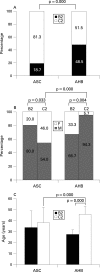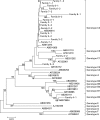Risk factors for acute hepatitis B and its progression to chronic hepatitis in Shanghai, China
- PMID: 18755887
- PMCID: PMC2582333
- DOI: 10.1136/gut.2008.157149
Risk factors for acute hepatitis B and its progression to chronic hepatitis in Shanghai, China
Abstract
Background and aims: The major risk factors for acute hepatitis B (AHB) in China and the viral factors determining the progression from acute to chronic hepatitis B remain largely unknown.
Methods: Epidemiological studies within a population-based surveillance for AHB in adults were performed in Shanghai, China, including 294 patients, 588 matched controls and 572 family members of the patients.
Results: Invasive medical procedures, household contact with hepatitis B virus (HBV) carriers, body care and beauty treatments, and lack of HBV vaccination were independently associated with AHB. Among those risks, pedicure in bath centres emerged. Sixty-eight of 128 patients with AHB were genotyped including 33 with HBV B2 and 35 with HBV C2. Twenty-five (8.50%) of the 294 patients, including 20 with HBV C2 and 5 with HBV B2 (p = 0.013), progressed to chronic infection. Multivariate analysis showed that HBV C2 was independently associated with chronicification of AHB. Patients with HBV B2 were younger and there was a higher proportion of women than those with HBV C2. The prevalence of HBV B2 was higher in the patients than in neighbourhood chronic carriers. The chronic carriers with HBV B2 showed higher viral loads, higher hepatitis B e antigen (HBeAg) seropositivity, and with higher proportion in men than those with HBV C2, implying that sexual contact plays a role in the transmission of HBV B2. Phylogenetic analysis showed that HBV C2 was frequently involved in transmissions within households.
Conclusions: Despite lower viral load and HBeAg status in the chronic carriers, HBV C2 was more prone to causing chronic infection than was HBV B2.
Conflict of interest statement
Figures





Comment in
-
HBV genotypes and chronicification of acute hepatitis B: more questions than answers.Gut. 2009 Jul;58(7):1027-8; author reply 1028-9. Gut. 2009. PMID: 19520895 No abstract available.
References
-
- Lavanchy D. Worldwide epidemiology of HBV infection, disease burden, and vaccine prevention. J Clin Virol 2005;34(Suppl 1):S1–3 - PubMed
-
- Custer B, Sullivan SD, Hazlet TK, et al. Global epidemiology of hepatitis B virus. J Clin Gastroenterol 2004;38(10 Suppl):S158–68 - PubMed
-
- Hwang LY, Kramer JR, Troisi C, et al. Relationship of cosmetic procedures and drug use to hepatitis C and hepatitis B virus infections in a low-risk population. Hepatology 2006;44:341–51 - PubMed
-
- Fisker N, Pedersen C, Lange M, et al. Molecular epidemiology of hepatitis B virus infections in Denmark. J Clin Virol 2004;31:46–52 - PubMed
-
- Redd JT, Baumbach J, Kohn W, et al. Patient-to-patient transmission of hepatitis B virus associated with oral surgery. J Infect Dis 2007;195:1311–4 - PubMed
Publication types
MeSH terms
LinkOut - more resources
Full Text Sources
Miscellaneous
